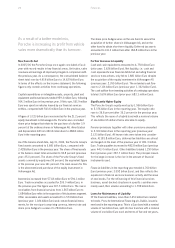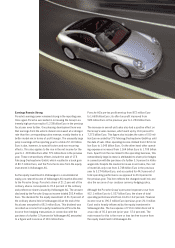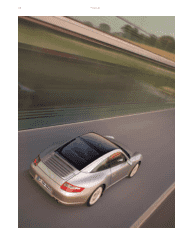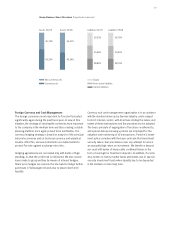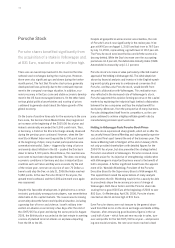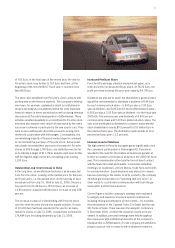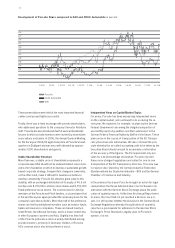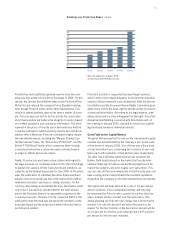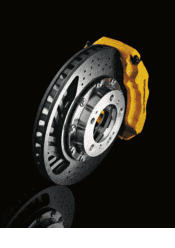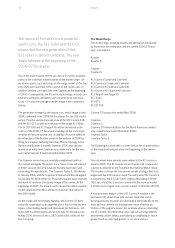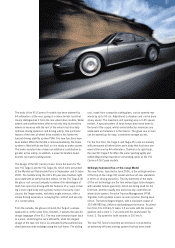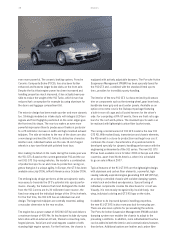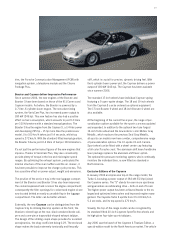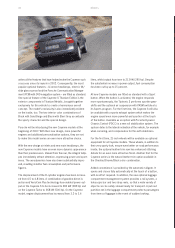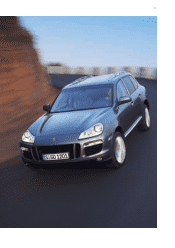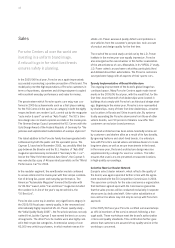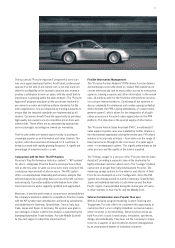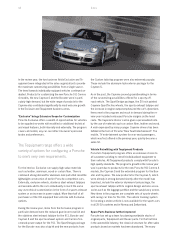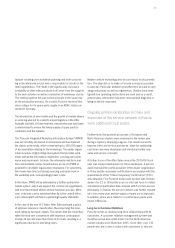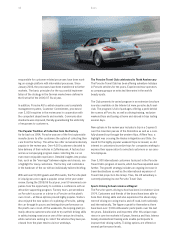Porsche 2005 Annual Report Download - page 38
Download and view the complete annual report
Please find page 38 of the 2005 Porsche annual report below. You can navigate through the pages in the report by either clicking on the pages listed below, or by using the keyword search tool below to find specific information within the annual report.36 Models
The launch of Porsche’s most powerful
sports cars, the 911 Turbo and the GT3,
means that the new generation of the
911 series is almost complete. The new
Targa followed at the beginning of the
2006/07 fiscal year.
One of the main reasons for the success of Porsche’s business
policy is the continual modernization of the model range. Se-
veral new sports cars and a top-of-the-range model of the Cay-
enne SUV were launched in the course of the review year. In
addition, dealers can expect the new Cayenne at the beginning
of 2007. Consequently, the Porsche model range not only con-
tinues to symbolize attributes such as sportiness and exclu-
sivity – it is also the youngest model range in the company’s
history.
The generation change for the sports cars, which began in mid-
2004, continued in the 2005/06 fiscal year. For the 911 model
series, Porsche unveiled new versions of the 911 Carrera 4 (S)
and the 911 GT3 as well as a new top-of-the-range 911 Turbo.
The 911 GT3 RS and 911 Targa 4 (S) will be introduced in the
course of the 2006/07 fiscal year rounding off the current ge-
neration of Porsche sports cars. In addition, Porsche added to
the attraction of the Boxster series in the summer of 2006 by
fitting new engines featuring VarioCam Plus technology to the
Boxster and Boxster S models. Summer 2006 also saw the
launch of an entry-level Cayman as a stable-mate for the very
successful Cayman S launched in November 2005.
The Cayenne series has successfully established itself on
the market alongside the sports cars. Since it was introduced
in 2002, around 140,000 Cayenne models have been sold,
exceeding all expectations. The Cayenne Turbo S, introduced
in January 2006, and the Cayenne S Titanium Edition (designed
exclusively for North America, Porsche’s largest sales market)
did much to reinforce the sporty image of the series. At the
beginning of 2007, Porsche is set to renew the entire Cayenne
model range and thereby continue to build on its position in
the SUV market.
As the image and technology flagship, the Carrera GT domi-
nated the supersports car segment with a host of new techno-
logies, a fascinating design and impressive performance com-
bined with excellent quality and practicality for everyday use.
In May 2006, the last of the 1,282 Carrera GTs rolled off the
line in Leipzig.
The Model Range
The model range, including models and derivatives introduced
by Porsche in the review year and the current 2006/07 fiscal
year, is as follows:
Boxster
Boxster S
Cayman
Cayman S
911 Carrera Coupé and Cabriolet
911 Carrera S Coupé and Cabriolet
911 Carrera 4 Coupé and Cabriolet
911 Carrera 4S Coupé and Cabriolet
911 Targa 4 and Targa 4S
911 Turbo
911 GT3
911 GT3 RS
Carrera GT (production ended May 2006)
Cayenne
Cayenne S
Cayenne S Titanium Edition (for the North American market
only, manufactured until November 2006)
Cayenne Turbo
Cayenne Turbo S
The following sections take a closer look at the characteristics
of the models introduced since the beginning of the review
year.
Four all-wheel drive variants were added to the 911 series in
autumn 2005. The 911 Carrera 4 and Carrera 4S coupés and
cabriolets debuted at the Frankfurt International Motor Show.
The models continue the two-power variant strategy that was
begun with the 911 Carrera coupé: the entry-level 911 Carrera 4
is powered by the 3.6-liter boxer engine developing 239 kW
(325 hp), whilst the S version comes with the more powerful
3.8-liter boxer engine with a power output of 261 kW (355 PS).
A characteristic feature of the 911 Carrera 4 models is the
permanent all-wheel drive with viscous multi-disk clutch.
Varying amounts of power are distributed automatically to the
front and rear wheels, facilitating even more effective uti-
lization of the engine’s power, for example when accelerating
out of corners. All-wheel drive also improves driving stability
and thereby active safety, particularly on undulating or loose
ground such as sand and gravel, or on snow and ice.


